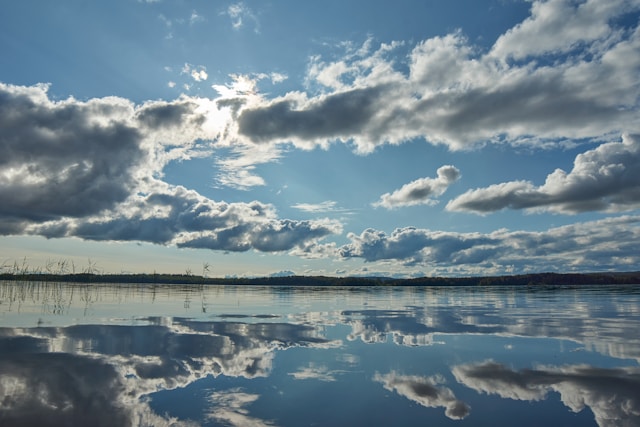Weather can vary greatly from place to place and is affected by the factors we discussed earlier, such as latitude, air masses, ocean currents, topography, and others. Weather forecasts provide information about expected weather conditions in different locations over a period of time, usually from a few hours to a few days.
What two factors determine the climate of a region?
The climate of a region is determined by two main factors:
- Temperature: Temperature plays a crucial role in determining the climate of a region. It refers to the measurement of the average kinetic energy of air molecules in the atmosphere. A region’s temperature is affected by a variety of factors, including latitude, altitude, prevailing winds, ocean currents, and proximity to large bodies of water;
- Precipitation: Precipitation is any form of water that falls from the atmosphere to the earth’s surface, including rain, snow, sleet, sleet, and hail. Precipitation is the most important determinant of a region’s climate.
Together, temperature and precipitation determine a region’s climate. These factors, along with other secondary factors such as humidity, wind patterns, and sunshine duration, interact to create different types of climate.
What is a microclimate?
A microclimate is a unique climatic condition that exists in a relatively small localized area, often different from a broader regional climate. These conditions can be influenced by a variety of factors, including:
- Topography: Changes in the landscape, such as hills, valleys, slopes, or bodies of water, can create microclimates. For example, a valley may be cooler because of a build-up of cold air, while a sunny, south-facing slope may be warmer and drier;
- Vegetation: The presence of vegetation can have a significant impact on the microclimate. Areas with dense vegetation can be cooler and wetter than open, barren areas;
- Urbanization: Urban areas often have their own microclimates, known as urban heat islands;
- Proximity to water: Large bodies of water, such as lakes, rivers, or oceans, can create microclimates that moderate temperatures. Coastal areas often have cooler temperatures due to the cooling effect of nearby water, while inland areas can be warmer;
- Aspect and orientation: The direction in which a place is located, such as north, south, east, or west, can affect the amount of sunlight and heat it receives.
Microclimates can have significant effects on agriculture, horticulture, and outdoor activities.
What factors affect precipitation?
Precipitation, the process by which water vapor condenses and falls to the Earth’s surface in the form of rain, snow, sleet, or hail, depends on several factors. These factors include:
- Availability of moisture: The presence of moisture in the atmosphere is crucial to precipitation. It depends on factors such as evaporation from water bodies, plant transpiration, and the amount of water vapor in the air. Regions with higher moisture content have a higher chance of precipitation;
- Air masses: The movement and interaction of different air masses play an important role in precipitation;
- Topography: The shape and elevation of the land can affect precipitation patterns. When air is forced to rise over mountains or hills, it cools and condenses, resulting in cloud formation and windward precipitation;
- Wind Character: The prevailing nature of the wind can affect precipitation by affecting the transport of moisture-containing air masses. Winds blowing from bodies of water can transport moisture inland, increasing the likelihood of precipitation;
- Proximity to bodies of water: Areas near large bodies of water, such as oceans, seas, or large lakes, tend to have more moisture in the air, increasing the likelihood of precipitation;
- Orographic effect: When air is forced to rise over high elevations such as mountains, it cools and condenses, resulting in increased cloud formation and precipitation on the windward side;
- Atmospheric instability: Unstable atmospheric conditions characterized by rapid changes in temperature and humidity with altitude can increase the likelihood of precipitation;
- Seasonal variations: Precipitation patterns can vary seasonally due to changes in factors such as solar radiation, temperature, and atmospheric circulation.
These factors interact in complex ways, and a particular combination of conditions determines the type, intensity, and distribution of precipitation in a given area.
What factors account for ocean currents?
Ocean currents are primarily influenced by several factors, including:
- Global wind patterns: Winds play an important role in the movement of ocean currents. Prevailing global winds, such as trade winds and westerly winds, create surface winds that push and pull surface ocean waters, initiating the movement of currents;
- Coriolis effect: The Earth’s rotation causes the Coriolis effect, which deflects moving air and water masses to the right in the Northern Hemisphere and to the left in the Southern Hemisphere;
- Earth’s rotation: The Earth’s rotation also affects ocean currents. As the Earth rotates, ocean currents tend to flow clockwise in the Northern Hemisphere and counterclockwise in the Southern Hemisphere. This phenomenon, known as Ekman transport, results from the combined effects of the Coriolis effect and wind;
- Temperature and density: Differences in water temperature and density determine the motion of ocean currents. Warm water is usually less dense than cold water, which causes it to rise and flow along the surface;
- Configuration of continents: The shape and location of continents and land can affect ocean currents. Continents can act as barriers or deflectors, changing the direction of ocean currents.
Ocean currents have a profound effect on global climate and weather patterns, distributing heat, nutrients, and moisture around the world.
Conclusions
“Location-specific weather” refers to the specific weather conditions observed at a particular location or geographic point. It is the current state of the atmosphere in terms of temperature, humidity, wind speed and direction, precipitation, cloud cover, and other atmospheric conditions at a particular point on the Earth’s surface.


